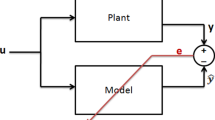Abstract
System identification can be divided into structure and parameter identification. In most system-identification approaches the structure is presumed and only a parameter identification is performed to obtain the coefficients in the functional system. Yet, often there is little knowledge about the system structure. In such cases, the first step has to be the identification of the decisive input variables. In this paper a black-box input variable identification approach using feedforward neural networks is proposed.
Similar content being viewed by others
Explore related subjects
Discover the latest articles, news and stories from top researchers in related subjects.References
Akaike, H.: 1974, A new look at statistical model indentification,IEEE Trans. Automat. Control 19, 716–723.
Bastian, A.: 1994, An effecitive way to generate neural network structures for function approximation, LIFE Tech. Rep., MATHWARE & Softcomputing, in press.
Bezdek, J. C: 1981,Pattern Recognition with Fuzzy Objective Function Algorithm, Plenum, New York.
Cybenko, G.: 1989, Approximation by superpositions of a sigmoidal function,Math. Ctrl., Signals, Sys. 2(4), 303–392.
Friedman, J. H.: 1988, Multivariate adaptive regression splines, Tech. Rep., Department of Statistics, Standord University, CA.
Fukuyama, Y. and Sugeno, M.: 1989, A new method of choosing the number of clusters for fuzzy c-means method, inProc. 5th Fuzzy System Symp., pp. 247–250 (in Japanese).
Hecht-Nielsen, R.: 1981,Neurocomputing, Addison-Wesley, MA.
Hornik, K., Stinchcomb, M., and White, H.: 1989, Multilayer feedforward networks are universal approximators,Neural Networks 2, 359–366.
Ihara, J.: 1990, Group method of data handling towards a modeling of complex systems IV,System and control 24, 158–168 (in Japanese).
Lin, C. T.: 1994, Neural Fuzzy Control Systems with Structure and Parameter Learning, World Scienctific.
Narendra, K. S. and Parthasarathy, K.: 1990, Identification and control of dynamical systems using neural networks,IEEE Trans. on Neural Networks 1(1), 4–27.
Ooyen, A. van and Nienhuis, B.: 1992, Improving the convergence of the back-propagation algorithm,Neural Networks 5, 465–471.
Pirez, Y. M. and Sarkar, D.: 1993, Back-propagation with controlled oscillation of weights, inProc. IEEE Int. Conf. on NNÊ93, pp. 21–26.
Rumelhart, D. E., Hinton, G. E., and Williams, R. J.: 1986, Learning representation by back-propagation errors,Nature 232, 533–536.
Sugeno, M. and Yasukawa, T.: 1993, A fuzzy-logic-based approach to qualitative modeling,IEEE Trans. on Fuzzy Systems 1(1), 7–31.
Vogl, T. P., Mangis, J. K., Rigler, A. K., Zink, W. T. and Alkon, D. L.: 1988, Accelerating the convergence of the back-propagation method,Biol. Cybern. 59, 257–263.
Yamada, T. and yabuta, T.: 1992, Neural network controller using autotuning method for nonlinear functions,IEEE Trans. on Neural Networks 3(4), 595–601.
Author information
Authors and Affiliations
Rights and permissions
About this article
Cite this article
Bastian, A., Gasós, J. Selection of input variables for model identification of static nonlinear systems. J Intell Robot Syst 16, 185–207 (1996). https://doi.org/10.1007/BF00449705
Received:
Accepted:
Issue Date:
DOI: https://doi.org/10.1007/BF00449705




